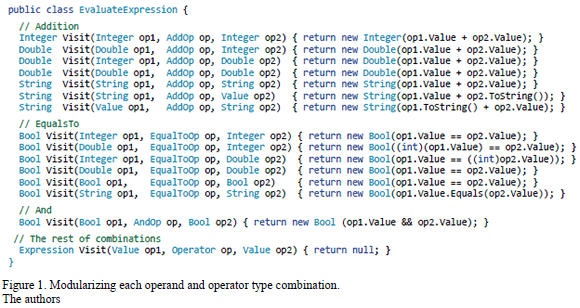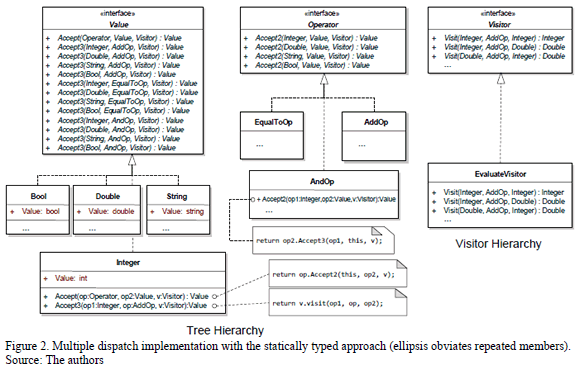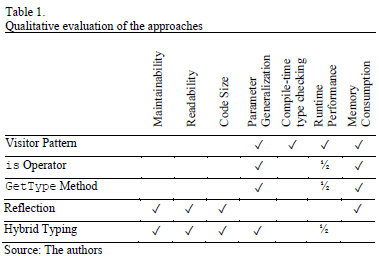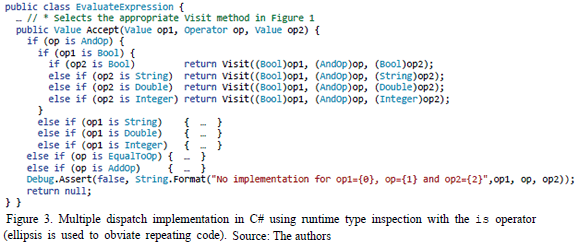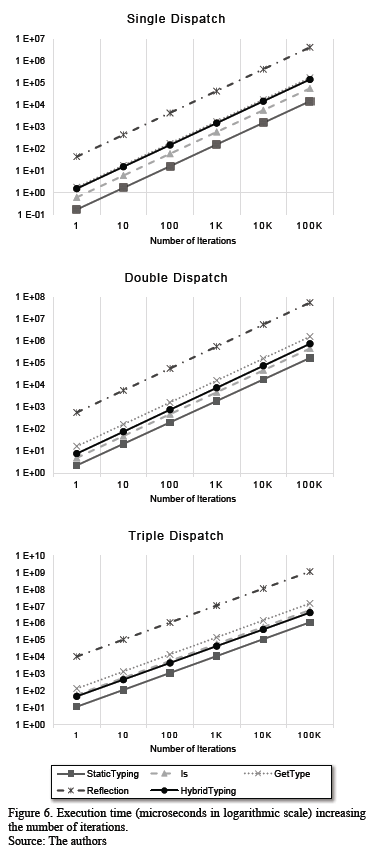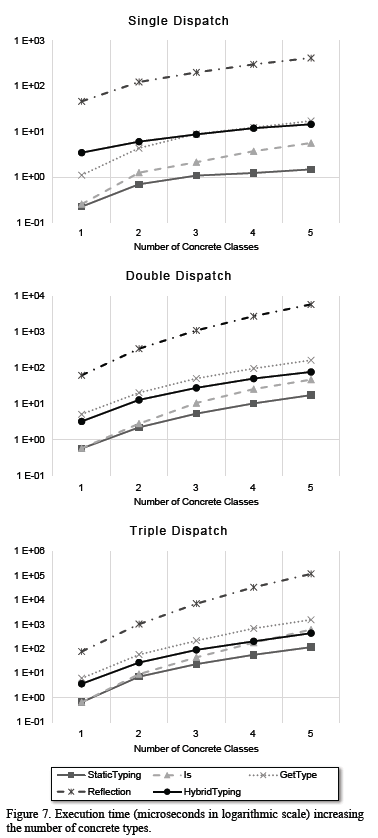Serviços Personalizados
Journal
Artigo
Indicadores
-
 Citado por SciELO
Citado por SciELO -
 Acessos
Acessos
Links relacionados
-
 Citado por Google
Citado por Google -
 Similares em
SciELO
Similares em
SciELO -
 Similares em Google
Similares em Google
Compartilhar
DYNA
versão impressa ISSN 0012-7353
Dyna rev.fac.nac.minas vol.81 no.186 Medellín jul./ago. 2014
https://doi.org/10.15446/dyna.v81n186.40428
http://dx.doi.org/10.15446/dyna.v81n186.40428
Attaining multiple dispatch in widespread object-oriented languages
Aproximaciones para obtener multi-métodos en los lenguajes orientados a objetos más extendidos
Francisco Ortin a, Jose Quiroga b, Jose M. Redondo c & Miguel Garcia d
a Computer Science Department, University of Oviedo, Spain, ortin@uniovi.es
b Computer Science Department, University of Oviedo, Spain, quirogajose@uniovi.es
c Computer Science Department, University of Oviedo, Spain, redondojose@uniovi.es
d Computer Science Department, University of Oviedo, Spain, garciarmiguel@uniovi.es
Received: October 23th, de 2013. Received in revised form: April 28th, 2014. Accepted: May 22th, 2014
Abstract
Multiple dispatch allows determining the actual method to be executed, depending on the dynamic types of its arguments. Although some programming languages provide multiple dispatch, most widespread object-oriented languages lack this feature. Therefore, different implementation techniques are commonly used to obtain multiple dispatch in these languages. We evaluate the existing approaches, presenting a new one based on hybrid dynamic and static typing. A qualitative evaluation is presented, considering factors such as software maintainability and readability, code size, parameter generalization, and compile-time type checking. We also perform a quantitative assessment of runtime performance and memory consumption.
Keywords: Multiple dispatch; multi-method; dynamic binding; reflection; method overload; hybrid typing.
Resumen
Los multi-métodos seleccionan una de las implementaciones de un método sobrecargado, dependiendo en el tipo dinámico de sus argumentos. Aunque existen lenguajes que soportan multi-métodos, la mayoría de los lenguajes más extendidos no ofrecen esta funcionalidad. Por ello, es común ver el uso de distintos mecanismos auxiliares para obtener su funcionalidad. En este artículo evaluamos las alternativas existentes y presentamos una nueva basada en lenguajes con tipado híbrido. Una primera evaluación cualitativa analiza factores como la mantenibilidad, legibilidad, tamaño del código fuente, generalización de los parámetros y comprobación estática de tipos. También presentamos una evaluación cuantitativa del rendimiento en tiempo de ejecución y consumo de memoria.
Palabras clave: Multi-métodos; enlace dinámico; reflexión; sobrecarga de métodos; tipado híbrido.
1. Introduction
Object-oriented programming languages provide dynamic binding as a mechanism to implement maintainable code. Dynamic binding is a dispatching technique that postpones the process of associating a message to a specific method until runtime. Therefore, when the toString message is passed to a Java object, the actual toString method called is that implemented by the dynamic type of the object, discovered by the virtual machine at runtime.
Although dynamic binding is a powerful tool, widespread languages such as Java, C# and C++ only support it as a single dispatch mechanism: the actual method to be invoked depends on the dynamic type of a single object. In these languages, multiple-dispatch is simulated by the programmer using specific design patterns, inspecting the dynamic type of objects, or using reflection.
In languages that support multiple-dispatch, a message can be dynamically associated to a specific method based on the runtime type of all its arguments. These multiple-dispatch methods are also called multi-methods [1]. For example, if we want to evaluate binary expressions of different types with different operators, multi-methods allow modularizing each operand-operator-operand combination in a single method. In the example C# code in Fig. 1, each Visit method implements a different kind of operation for three concrete types, returning the appropriate value type.
As shown in Fig. 2, the values and operators implement the Value and Operator interface, respectively. Taking two Value operands and an Operator, a multi-method is able to receive these three parameters and dynamically select the appropriate Visit method to be called. It works like dynamic binding, but with multiple types. In our example, a triple dispatch mechanism is required (the appropriate Visit method to be called is determined by the dynamic type of its three parameters).
Polymorphism can be used to provide a default behavior if one combination of two expressions and one operator is not provided. Since Value and Operator are the base types of the parameters (Fig. 2), the last Visit method in Fig. 1 will be called by the multiple dispatcher when there is no other suitable Visit method with the concrete dynamic types of the arguments passed. An example is evaluating the addition (AddOp) of two Boolean (Bool) expressions.
In this paper, we analyze the common approaches programmers use to simulate multiple dispatching in those widespread object-oriented languages that only provide single dispatch (e.g., Java, C# and C++). To qualitatively compare the different alternatives, we consider factors such as software maintainability and readability, code size, parameter generalization, and compile-time type checking. A quantitative assessment of runtime performance and memory consumption is also presented. We also present a new approach to obtain multiple dispatch in languages that provide hybrid dynamic and static typing, such as C#, Objective-C, Boo and Cobra. This alternative provides high maintainability and readability, requires reduced code size, allows parameter generalization, and performs significantly better than the reflective approach. In contrast, it requires 31% more memory resources than the other alternatives.
The rest of this paper is structured as follows. In Section 2, the common approaches to obtain multi-methods in widespread object-oriented programming languages are presented and qualitatively evaluated. Section 3 presents a new approach for hybrid typing languages, and a comparison with the previously analyzed systems. Section 4 details the runtime performance and memory consumption evaluation. Conclusions and future work are presented in Section 5.
2. Common approaches
2.1. The Visitor design pattern
The Visitor design pattern is a very common approach to obtain multiple dispatch in object-oriented languages that do not implement multi-methods [2]. By using method overloading, each combination of non-abstract types is implemented in a specific Visit method (Fig. 1). Static type checking is used to modularize each operation in a different method. The compiler solves method overloading by selecting the appropriate implementation depending on the static types of the parameters.
Suppose an n-dispatch scenario: a method with n polymorphic parameters, where each parameter should be dynamically dispatched considering its dynamic type (i.e., multiple dynamic binding). In this n-dispatch scenario, the n parameters belong to the H1, H2... Hn hierarchies, respectively. Under these circumstances, there are potentially  Visit methods, CCi being the number of concrete (non-abstract) classes in the Hi hierarchy.
Visit methods, CCi being the number of concrete (non-abstract) classes in the Hi hierarchy.
Using polymorphism, parameters can be generalized in groups of shared behavior (base classes or interfaces). An example of this generalization is the two last addition methods in Fig. 1. They generalize the way strings are concatenated with any other Value. This feature that allows grouping implementations by means of polymorphism is the parameter generalization criterion mentioned in the previous section.
As shown in Fig. 2, the Visitor pattern places the Visit methods in another class (or hierarchy) to avoid mixing the tree structures to be visited (Value and Operator) with the traversal algorithms (Visitor) [3]. The (single) dispatching mechanism used to select the correct Visit method is dynamic binding [2]. A polymorphic (virtual) method must be declared in the tree hierarchy, because that is the hierarchy the specific parameter types of the Visit methods belong to. In Fig. 2, the Accept method in Value provides the multiple dispatch. When overriding this method in a concrete Value class, the type of this will be non-abstract, and hence the specific dynamic type of the first parameter of Visit will be known. Therefore, by using dynamic binding, the type of the first parameter is discovered. This process has to be repeated for every parameter of the Visit method. In our example (Fig. 2), the type of the second operand is discovered with the Accept2 method in Operator, and Accept3 in Value discovers the type of the third parameter before calling the appropriate Visit method.
In this approach, the number of AcceptX method implementations grows geometrically relative to the dispatch dimensions (i.e., the n in n-dispatch, or the number of the Visit parameters). Namely, for H1, H2... Hn hierarchies of the corresponding n parameters in Visit, the number of Accept methods are 1+ . Therefore, the code size grows geometrically with the number of parameters in the multi-method. Additionally, declaring the signature of each single AcceptX method is error-prone and reduces its readability.
. Therefore, the code size grows geometrically with the number of parameters in the multi-method. Additionally, declaring the signature of each single AcceptX method is error-prone and reduces its readability.
Adding a new concrete class to the tree hierarchy requires adding more AcceptX methods to the implementation (see the formula in the previous paragraph). This feature reduces the maintainability of this approach, causing the so-called expression problem [4]. This problem is produced when the addition of a new type to a type hierarchy involves changes in other classes.
The Visitor approach provides different advantages. First, the static type error detection provided by the compiler. Second, the best runtime performance (see Section 4). Finally, parameter generalization, as mentioned, is also supported. A summary of the pros and cons of all the approaches is presented in Table 1.
2.2. Runtime type inspection
In the previous approach, the dispatcher is implemented by reducing multiple-dispatch to multiple cases of single dispatch. Its high dependence on the number of concrete classes makes it error-prone and reduces its maintainability. This second approach implements a dispatcher by consulting the dynamic type of each parameter in order to solve the specific Visit method to be called. This type inspection could be performed by either using an is type of operator (e.g., is in C# or instanceof in Java) or asking the type of an object at runtime (
e.g., GetType in C# or getClass in Java). Fig. 3 shows an example implementation in C# using the is operator. Notice that this single Accept method is part of the EvaluateExpression class in Fig. 1 (it does not need to be added to the tree hierarchy).
Fig. 3 shows the low readability of this approach for our triple dispatch example with seven concrete classes. The maintainability of the code is also low, because the dispatcher implementation is highly coupled with the number of both the parameters of the Visit method and the concrete classes in the tree hierarchy. At the same time, the code size of the dispatcher grows with the number of parameters and concrete classes.
The is operator approach makes extensive use of type casts. Since cast expressions perform type checks at runtime, this approximation loses the robustness of full compile-time type checking. The GetType approach also has this limitation together with the use of strings for class names, which may cause runtime errors when the class name is not written correctly. Parameter generalization is provided by means of polymorphism. As discussed in Section 4, the runtime performance of these two approaches (is and GetType) is not as good as that of the previous alternative.
2.3 Reflection
The objective of the reflection approach is to implement a dispatcher that does not depend on the number of concrete classes in the tree hierarchy. For this purpose, not only the types of the parameters but also the methods to be invoked are discovered at runtime. The mechanism used to obtain this objective is reflection, one of the main techniques used in meta-programming [5]. Reflection is the capability of a computational system to reason about and act upon itself, adjusting itself to changing conditions [6]. Using reflection, the self-representation of programs can be dynamically consulted and, sometimes, modified [7].
As shown in Fig. 5, the dynamic type of an object can be obtained using reflection (GetType). It is also possible to retrieve the specific Visit method implemented by its dynamic type (GetMethod), passing the dynamic types of the parameters. It also provides the runtime invocation of dynamically discovered methods (Invoke).
The code size of this approach does not grow with the number of concrete classes. Moreover, the addition of another parameter does involve important changes in the code. Consequently, as shown in Table 1, this approach is more maintainable than the previous ones. Although the reflective Accept method in Fig. 4 may be somewhat atypical at first, we think its readability is certainly higher than the one in Fig. 3.
The first drawback of this approach is that no static type checking is performed. If Accept invokes a nonexistent Visit method, an exception is thrown at runtime, but no compilation error is produced. Another limitation is that parameter generalization is not provided because reflection only looks for one specific Visit method. If an implementation with the exact signature specified does not exist, no other polymorphic implementation is searched (e.g., the last Visit method in Fig. 1 is never called). Finally, this approach showed the worst runtime performance in our evaluation (Section 4).
3. A hybrid typing approach
Hybrid static and dynamic typing (henceforth referred to simply as hybrid typing) languages provide both typing approaches in the very same programming language. Programmers may use one alternative or the other depending on their interests, following the static typing where possible, dynamic typing when needed principle [8].
In the case of multiple dispatch, we have used static typing to modularize the implementation of each operand and operator type combination (Visit methods in Fig. 1). We propose the use of dynamic typing to implement multiple dispatchers that dynamically discover the suitable Visit method to be invoked.
In a hybrid typing language, its static typing rules are also applied at runtime when dynamic typing is selected. This means that, for instance, method overload is postponed until runtime, but the resolution algorithm stays the same [9]. We have used this feature to implement a multiple dispatcher that discovers the correct Visit method to be invoked at runtime, using the overload resolution mechanism provided by the language. At the same time, parameter generalization by means of polymorphism is also achieved.
Fig. 5 shows an example of a multiple dispatch implementation (Accept method) in C#. With dynamic, the programmer indicates that dynamic typing is preferred, postponing the overload resolution until runtime. The first maintainability benefit is that the dispatcher does not depend on the number of concrete classes in the tree hierarchy (the expression problem [4]). Besides, another dispatching dimension can be provided by simply declaring one more parameter, and passing it as a new argument to Visit. The dispatcher consists in a single invocation to the overloaded Visit method, indicating which parameters require dynamic binding (multiple dispatching) with a cast to dynamic. If the programmer wants to avoid dynamic binding for a specific parameter, this cast to dynamic will not be used. This simplicity makes the code highly readable and reduces its size considerably (Table 1). At the same time, since the overload resolution mechanism is preserved, parameter generalization by means of polymorphism is also provided (i.e., polymorphic methods like the two last addition implementations for strings in Fig. 1).
In C#, static type checking is disabled when the dynamic type is used, lacking the compile-time detection of type errors. However, there are research works on hybrid typing languages, such as the StaDyn programming language [10], which provide static type checking when the dynamic type is used. When this feature is not supported, the best approach is to use static types to declare the Accept parameters using polymorphism (restricting their types to Value and Operator, as shown in Fig. 5). At the same time, exception handling is another mechanism that can be used to make the code more robust -notice that parameter generalization reduces the number of possible exceptions to be thrown, compared to the reflection approach.
Finally, this approach shows a runtime performance between the statically typed implementation and the reflective one (see Section 4). Hybrid typing languages, including C#, commonly implement a dynamic cache to improve runtime performance of dynamically typed code [11]. This technique provides a significant runtime performance improvement compared to reflection [12].
4. Evaluation
In this section, we measure execution time and memory consumption of the five different approaches analyzed. Detailed information is presented to justify the performance and memory assessment in the two last columns of Table 1.
4.1. Methodology
In order to compare the performance of the proposed approaches, we have developed a set of synthetic micro-benchmarks. These benchmarks measure the influence of the following variables on runtime performance and memory consumption:
- Dispatch dimensions. We have measured programs executing single, double and triple dispatch methods. These dispatch dimensions represent the number of parameters passed to the Accept method shown in Figs. 3, 4 and 5.
- Number of concrete classes. This variable is the number of concrete classes of each parameter of the Accept method. For each one, we define from 1 to 5 possible derived concrete classes. Therefore, the implemented dispatchers will have to select the correct Visit method out of up to 125 different implementations (53).
- Invocations. Each program is called an increasing number of times to analyze their performance in long-running scenarios (e.g., server applications).
- Approach. The same application is implemented using the static typing, runtime type inspection (is and GetType alternatives), reflection, and hybrid typing approaches.
Each program implements a collection of Visit methods that simply increment a counter field. The idea is to measure the execution time of each dispatch technique, avoiding additional significant computation -we have previously evaluated a more realistic application in [13].
Regarding the data analysis, we have followed the methodology proposed in [14] to evaluate the runtime performance of applications, including those executed on virtual machines that provide JIT compilation. We have followed a two-step methodology:
- We measure the elapsed execution time of running multiple times the same program. This results in p (we have taken p = 30) measurements xi with 1≤ i ≤ p.
- The confidence interval for a given confidence level (95%) is computed to eliminate measurement errors that may introduce a bias in the evaluation. The confidence interval is computed using the Student's t-distribution because we took p = 30 [15]. Therefore, we compute the confidence interval [c1,c2] as:

where  is the arithmetic mean of the xi measurements, a = 0.05(95%), s is the standard deviation of the xi measurements, and
is the arithmetic mean of the xi measurements, a = 0.05(95%), s is the standard deviation of the xi measurements, and  is defined such that a random variable T, that follows the Student's t-distribution with
is defined such that a random variable T, that follows the Student's t-distribution with  degrees of freedom, obeys
degrees of freedom, obeys

The memory consumption has been measured following the same methodology to determine the memory used by the whole process. All the tests were carried out on a lightly loaded 3.4 GHz Intel Core I7 2600 system with 16 GB of RAM running an updated 64-bit version of Windows 8 Professional.
4.2. Runtime performance
Fig. 6 shows the execution time of single, double and triple dispatch, when each parameter of the multi-method has five concrete derived types. Each Visit method is executed at least once. To analyze the influence of the number of invocations on the execution time, we invoke multi-methods in loops from 1 to 100,000 iterations. Fig. 6 shows the average execution time for a 95% confidence level, with an error interval lower than 2%.
As can be seen in Fig. 6, all the approaches have a linear influence of the number of iterations on execution time. However, the dispatch dimension (i.e., the number of multi-method parameters) of the analyzed approaches shows a different influence. For single dispatch, the hybrid typing approach is 19% and 2,787% faster than GetType and reflection, respectively, but requires 157% and 876% more execution time than is and static typing. For double dispatch, the runtime performance of the hybrid approach improves in comparison with the rest of alternatives (Fig. 6). For triple dispatch, the hybrid static and dynamic typing alternative is the second fastest one, performing 1.4, 2.5 and 265 times better than is, GetType and reflection, respectively (static typing is 2.7 times faster than hybrid typing in this scenario).
Fig. 7 shows execution time, when the number of concrete classes that implement each multi-method parameter increases (for 100,000 fixed iterations). For each parameter, we increment (from 1 to 5) the number of its derived concrete classes. In the case of triple dispatch and five different concrete classes, the multiple dispatcher has to select the correct Visit method out of 125 (53) different implementations.
As shown in Fig. 7, the relative performance of the hybrid approach improves as the number of concrete classes increases. For single dispatch, hybrid typing requires 213% more execution time than GetType for one concrete type of the single parameter; however, the hybrid approach is 19% faster than GetType for five different concrete types. For double dispatch, the hybrid approach improves its relative performance, being faster than GetType for any number of classes. When the dimension of the dispatch is triple, the relative runtime performance of the hybrid approach also improves as the number of concrete classes increases. With five different types for each of the three parameters, the hybrid approach is the second fastest one, being 40% faster than is and 265 times faster than reflection (static typing is 2.7 times faster than hybrid typing).
4.3. Memory consumption
We have measured memory consumption, analyzing all the variables mentioned in the Section 4.1. There is no influence of the number of iterations, the dimensions of dispatch, or the number of concrete classes, in the memory consumed by the benchmark.
The memory required by all approaches except hybrid typing are similar (the difference is 1%, lower than the 2% error interval). However, the hybrid approach involves an average increase of 31% compared with the other approaches. This difference is due to the use of the Dynamic Language Runtime (DLR) [16]. The DLR is a new layer over the CLR to provide a set of services to facilitate the implementation of dynamic languages. The DLR implements a runtime cache to optimize runtime performance of dynamically typed operations, performing better than reflection (as shown in Figs. 6 and 7) [13].
However, this runtime performance improvement also requires additional memory resources.
5. Related work
In this section, we describe the existing languages and frameworks that provide multiple dispatch [17]. CLOS [18] and Clojure [19] are examples of dynamically typed languages that include multi-methods in their semantics. Clojure has recently created a port for .Net that makes use of the DLR [20]. These approaches are fully dynamic, detecting all the type errors at runtime.
Xtend is a Java extension that provides statically typed multiple dispatch [21]. Method resolution and binding in Xtend are done at compile time as in Java. Dylan [22], Cecil [1] and, recently, Groovy 2 [23] are programming languages that provide both dynamic and static typing. Although these three languages support dynamically typed multi-methods, multiple dispatch can also be achieved with the hybrid typing approach proposed in this article.
Many different approaches exist to provide multiple dispatch for the Java platform. One of the first works is Runabout, a library to support two-argument dispatch (i.e.,
double dispatch) for Java [24]. Runabout is based on improving a previous reflective implementation of the Visitor pattern called Walkabout [25]. The appropriate method implementation is found via reflection, but method invocation is performed by generating Java bytecode at runtime performing better than Walkabout.
Dynamic Dispatcher is a double-dispatch framework for Java [26]. Three different dispatch methods are provided, combining the use of reflection and dynamic code generation. It provides the generalization of multi-method parameters by means of polymorphism.
Sprintabout is another double-dispatch alternative for Java, provided as a library [27]. Sprintabout uses a naming convention to identify multi-methods. Multi-methods implement a runtime type inspection dispatch (the GetType approach). The dispatch object implements a cache to efficiently obtain the different method implementations at runtime, avoiding the use of reflection.
MultiJava is a backward-compatible extension of Java that supports any dispatch dimension (not just double dispatch) [28]. Given a set of multi-method implementations, the MultiJava compiler produces a single Java dispatch method containing the bodies of the set of multi-method implementations. The multi-method implements the runtime type inspection approach, using the instanceof Java operator (is in C#).
The Java Multi-Method Framework (JMMF) uses reflection to provide multiple dispatch for Java [29]. Multi-methods can be defined in any class and with any name. JMMF is provided as a library; it proposes neither language extensions nor virtual machine modifications.
PolyD is aimed at providing a flexible multiple dispatch technique for Java [30]. PolyD generates Java bytecodes dynamically, and allows the user to define customized dispatching policies. Three standard dispatching policies are available: multiple dispatching (cached GetType runtime type inspection), overloading (static method overload) and a non-subsumptive' policy (only calls a method if the classes of the arguments match exactly those of the method parameters; i.e. no parameter generalization).
6. Conclusions
Different alternatives are nowadays used to achieve multiple dispatch in widespread languages that do not provide multi-methods. A qualitative evaluate has shown the pros and cons of each approach.
A new alternative has been described for hybrid typing languages. Their benefits are high readability and maintainability, loose coupling with the number of concrete classes and the dispatch dimensions, and parameter generalization. The main limitation is no compile-time type error detection. Its runtime performance is analogous to the runtime type inspection approaches. The average execution time of all the measured hybrid programs took 3.9 times more execution time the Visitor design pattern, being 36.6 times faster than reflection. The proposed approach has consumed 31% more memory resources than the rest of alternatives.
Since the main limitation of the hybrid typing approach is its lack of compile-time error detection, we are currently working on defining and implementing a hybrid language that provides compile-time type checking [10]. That language, called StaDyn, is an extension of C# that performs type inference over dynamic references. This C# extension may eventually detect some type errors of the hybrid typing approach at compile-time [31]. Another future work will be analyzing the suitability of implementing multi-methods in Java using the new invokedynamic opcode [32].
All the programs used in the evaluation of runtime performance and memory consumption, and the detailed measurement data are freely available at http://www.reflection.uniovi.es/stadyn/download/2013/dyna.zip
Acknowledgements
This work has been partially funded by Microsoft Research and the Department of Science and Innovation (Spain) under the National Program for Research, Development and Innovation: project TIN2011-25978.
References
[1] Chambers, G., Object-oriented multi-methods in Cecil. European Conference on Object-Oriented Programming (ECOOP). The Netherlands, 1992, pp. 33-56. [ Links ]
[2] Erich, G., Richard, H., Ralph, J. and John, V., Design patterns: Elements of reusable object-oriented software. Addison Wesley, 1995. [ Links ]
[3] Ortin, F., Zapico, D. and Cueva, J.M., Design patterns for teaching type checking in a compiler construction course, IEEE Transactions on Education 50, pp. 273-283, 2007. [ Links ]
[4] Torgersen, M., The expression problem revisited. European Conference on Object-Oriented Programming (ECOOP). Oslo, Norway, 2004, pp. 123-146. [ Links ]
[5] Ortin, F., López, B. and Pérez-Schofield, J.B.G., Separating adaptable persistence attributes through computational reflection, IEEE Software 21, pp. 41-49, 2004. [ Links ]
[6] Maes, P., Computational Reflection. PhD Thesis, Laboratory for Artificial Intelligence, Vrije Universiteit, Amsterdam, The Netherlands, 1987. [ Links ]
[7] Redondo, J.M. and Ortin, F., Efficient support of dynamic inheritance for class- and prototype-based languages, Journal of Systems and Software 86, pp. 278-301, 2013. [ Links ]
[8] Meijer, E. and Drayton, P., Static typing where possible, dynamic typing when needed: The end of the cold war between programming languages. OOPSLA 2004 Workshop on Revival of Dynamic Languages. Vancouver, Canada, 2004, pp.1-6. [ Links ]
[9] Bierman, G., Meijer, E. and Torgersen, M., Adding dynamic types to C#. European Conference on Object-Oriented Programming (ECOOP). Maribor, Slovenia, 2010, pp. 76-100. [ Links ]
[10] Ortin, F., Zapico, D., Perez-Schofield, J.B.G. and Garcia, M., Including both static and dynamic typing in the same programming language, IET Software, 4, pp. 268-282, 2010. [ Links ]
[11] Ortin, F., Redondo, J.M. and Perez-Schofield, J.B.G., Efficient virtual machine support of runtime structural reflection, Science of computer Programming 74, pp. 836-860, 2009. [ Links ]
[12] Redondo, J.M., Ortin, F. and Cueva, J.M., Optimizing reflective primitives of dynamic languages, International Journal of Software Engineering and Knowledge Engineering 18, pp. 759-783, 2008. [ Links ]
[13] Ortin, F., Garcia, M., Redondo, J.M. and Quiroga, J., Achieving multiple dispatch in hybrid statically and dynamically typed languages. World Conference on Information Systems and Technologies (WorldCIST), Advances in Information Systems and Technologies 206, pp. 703-713, 2013. [ Links ]
[14] Georges, A., Buytaert, D. and Eeckhout, L., Statistically rigorous Java performance evaluation. Object-Oriented Programming, Systems, Languages & Applications (OOPSLA). Montreal, 2007. Pp.57-76. [ Links ]
[15] Lilja, D.J., Measuring computer performance: A practitioner's guide. Cambridge University Press, 2005. [ Links ]
[16] Chiles, B. and Turner, A., Dynamic Language Runtime [May 2014] Available at: http://www.codeplex.com/Download?ProjectName=dlr&DownloadId=127512. [ Links ]
[17] Gómez-Luna, E., Fernando-Navas, D., Aponte-Mayor, G. and Betancour-Buitrago, L.A., Literature review methodology for scientific and information management, through its structuring and systematization, DYNA 81 (184), pp 158-163, 2014. [ Links ]
[18] DeMichiel, L.G. and Gabriel, R.P., The common lisp object system: An overview. European Conference on Object-Oriented Programming (ECOOP). Paris, France, 1987, pp.151-170. [ Links ]
[19] Hickey, R., The Clojure programming language. Symposium on Dynamic Languages (DLS). Paphos, Cyprus, 2008, pp.1-10. [ Links ]
[20] ClojureCLR., A port of Clojure to the CLR, part of the Clojure project [May 2014]. Available at: https://github.com/clojure/clojure-clr [ Links ]
[21] Eclipse Project, Xtend, Java 10 today! [May 2014] Available at: http://www.eclipse.org/xtend. [ Links ]
[22] Shalit, A., The Dylan reference manual: The definitive guide to the new object-oriented dynamic language. Addison Wesley Longman Publishing, 1996. [ Links ]
[23] Groovy 2.0 release notes. A "static theme" for a dynamic language. [May 2014] Available at: http://groovy.codehaus.org/Groovy+2.0+release+notes [ Links ]
[24] Grothoff, C., Walkabout revisited: The Runabout. European Conference on Object-Oriented Programming (ECOOP). Darmstadt, Germany, 2003, pp. 103-125. [ Links ]
[25] Palsberg, J. and Jay, C.B., The essence of the visitor pattern. Computer Software and Applications Conference (COMPSAC). Vienna, Austria, 1998, pp. 9-15. [ Links ]
[26] Büttner, F., Radfelder, O., Lindow, A. and Gogolla, M., Digging into the visitor pattern. International Conference on Software Engineering & Knowledge Engineering (SEKE). Banff, Alberta, Canada, 2004, pp. 135-141. [ Links ]
[27] Forax, R., Duris, E. and Roussel, G., Reflection-based implementation of Java extensions: The double-dispatch use-case. Symposium on Applied Computing (SAC). Santa Fe, New Mexico, 2005, pp. 1409-1413. [ Links ]
[28] Clifton, C., Leavens, G.T., Chambers, G. and Millstein, T., MultiJava: Modular open classes and symmetric multiple dispatch for Java. Object-Oriented Programming Systems, Languages, and Applications (OOPSLA). Minneapolis, Minnesota, 2000, pp. 130-145. [ Links ]
[29] Forax, R., Duris, E. and Roussel, G., A reflective implementation of Java multi-methods, IEEE Transactions on Software Engineering 30, pp. 1055-1071, 2004. [ Links ]
[30] Cunei, A. and Vitek, J., An efficient and flexible toolkit for composing customized method dispatchers, Software: Practice and Experience 38, pp. 33-73, 2008. [ Links ]
[31] Ortin, F., Type inference to optimize a hybrid statically and dynamically typed language, Computer Journal 54, pp. 1901-1924, 2011. [ Links ]
[32] Ortin, F., Conde, P., Fernandez-Lanvin, D. and Izquierdo, R., A runtime performance of invokedynamic: Evaluation with a Java library, IEEE Software 31, pp. 1-16, 2014. [ Links ]
Francisco Ortin, Born in 1973, he is an Associate Professor of the Computer Science Department at the University of Oviedo, Spain. He is the head of the Computational Reflection research group (www.reflection.uniovi.es). He received his BSc in Computer Science in 1994, and his MSc in Computer Engineering in 1996. In 2002, he was awarded his PhD entitled A Flexible Programming Computational System developed over a Non-Restrictive Reflective Abstract Machine. He has been the principal investigator of different research projects funded by Microsoft Research and the Spanish Department of Science and Innovation. His main research interests include dynamic languages, type systems, aspect-oriented programming, computational reflection, and runtime adaptable applications. ORCID: 0000-0003-1199-8649
Jose Quiroga, Born in 1982, he is a Research Assistant of the Computer Science Department at the University of Oviedo. He was awarded his BSc degree in Computer Science in 2004 and, in 2009, an MSc in Computer Engineering. He worked in the Research and Development department of the CTIC Foundation until 2012, when he became a Research Assistant financed by the Spanish Department of Competitiveness and Productivity. As a PhD student, he is doing research on the optimization of dynamically typed programming languages, performing compile-time inference of type information. ORCID: 0000-0002-1646-4796
Jose M. Redondo, Born in 1978, he is an Assistant Professor of the Computer Science Department at the University of Oviedo, Spain. He received his BSc in Computer Science in 2000, and his MSc in Computer Engineering in 2002. In 2007, he was awarded his PhD entitled Improving the performance of structural reflection using JIT compilation techniques. He has participated in different research projects funded by Microsoft Research and the Spanish Department of Science and Innovation. His main research interests include virtual machines, JIT compilation, computational reflection, and runtime adaptable applications. ORCID: 0000-0002-0939-0186
Miguel Garcia, Born in 1979, he is a Postdoctoral Research Assistant of the Computer Science Department at the University of Oviedo. He received his BSc degree in Computer Science in 2005. In 2008, he was awarded an MSc in Web Engineering, and an MSc in Software Engineering Research in 2010. In 2013, he presented his PhD dissertation entitled Improving the Runtime Performance and Robustness of Hybrid Static and Dynamic Typing Languages. His research interests include compiler construction, programming languages design, and aspect-oriented software development. ORCID: 0000-0002-3150-2826













